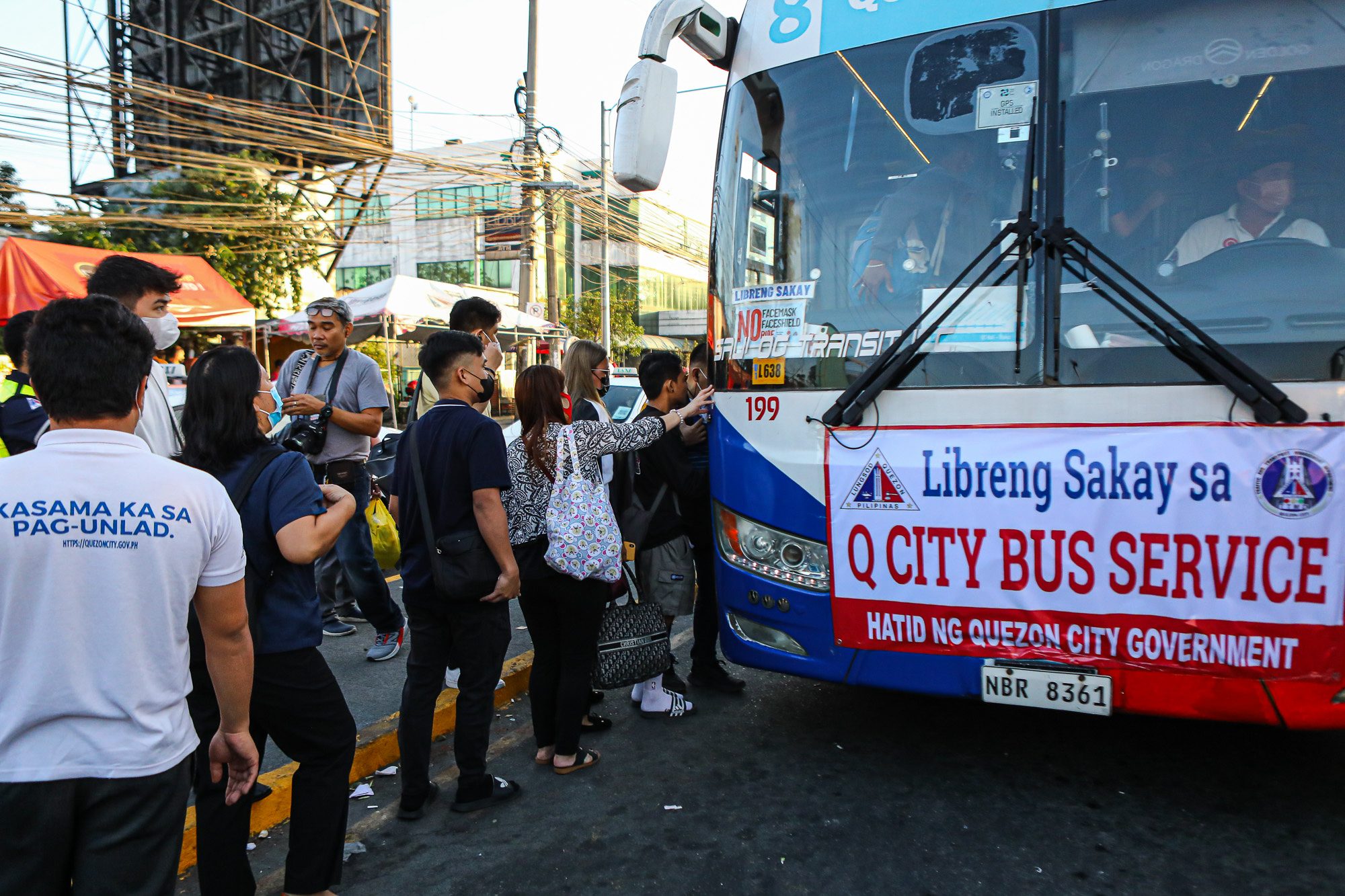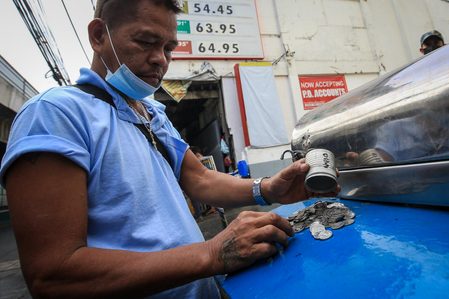SUMMARY
This is AI generated summarization, which may have errors. For context, always refer to the full article.

MANILA, Philippines – Metro Manila mayors have begun preparing vehicles run by local government units (LGUs) to assist commuters who may be affected by the week-long transportation strike beginning Monday, March 6.
Quezon City Mayor Joy Belmonte announced that the city’s traffic and transport management department would place Quezon City Bus Service units on standby for possible deployment to “areas with a high number of stranded passengers.”
These areas will include Cubao, Commonwealth Avenue, Mabuhay Rotonda, Novaliches Bayan, East Avenue, Quezon Memorial Circle, Fairview, and the Land Transportation Franchising and Regulatory Board (LTFRB).
“Makatutulong ang ating mga Q City Bus para mapagaan ang epekto ng transport strike,” said Belmonte. (Our Q City Buses will help lighten the effects of the transport strike.)
Pasay City Mayor Emi Calixto-Rubiano said that the city will deploy around 35 motorized vehicles to provide free rides for passengers. In a dialogue held on Thursday, March 2, leaders of at least 10 cooperatives and transport groups in Pasay City gave assurances that they would not participate in the transport strike.
Navotas Mayor John Rey Tiangco likewise said that Navoteños can expect free rides from city government and barangay vehicles.
The vehicles, part of the free ride program of Navotas, will ply the following routes from 6 am to 8 pm:
- C4 – Monumento and vice versa (NavoTours Bus)
- C4 – Divisoria and vice versa (Utility Truck 1)
- Dagat Dagatan/Agora – Pier and vice versa (Utility Truck 2)
- C4 – Tangos and vice versa (barangay service vehicles)
- SRV – C4 and vice versa (barangay service vehicles)
Taguig City also announced its free ride program, which includes seven routes that will traverse the city.
The Manila LGU deployed more than 300 vehicles for its own free ride program, particularly during rush hours. These included 280 e-tricycles, and 32 larger vehicles ranging from buses, pick-ups, and trucks.
The following routes will be available to the riding public from 5 am to 10 am, and 4 pm to 10 pm.
- Vito Cruz Taft Ave – Quezon Blvd.
- Espana Blvd. – Welcome Rotonda
- Abad Santos Ave. – R. Papa Rizal Ave.
- UN Taft Ave. – R. Papa Rizal Ave.
- Recto Ave. – SM Sta. Mesa
- UN Taft Ave. – P. Ocampo St.
- Monumento Rizal Ave. – Divisoria
- Buendia Taft Ave. – Divisoria
- Buendia Taft Ave. – Monumento Rizal Ave.
- Buendia Taft Ave. – Welcome Rotonda
Meanwhile, in Pasig, there are 43 buses, commuter trucks, and other service vehicles that will traverse the following routes until March 12:
- Pasig Mega Market to Shaw Boulevard (vice versa)
- Pasig Mega Market to Ligaya via Dr. Sixto Antonio Ave. (vice versa)
- Pasig Mega Market to Kalawaan to San Joaquin to Pasig Mega Market (loop)
- Pasig Mega Market to Ligaya via C. Raymundo Ave. (vice versa)
- Pasig Mega Market to Dr. Sixto Antonio Ave. to Rosario to C. Raymundo Ave. to Pasig Mega Market (loop)
In San Juan, Mayor Francis Zamora also announced three executive orders (EOs) in response to the transport strike.
The orders included EO 140, series of 2023, mandating free rides by city and barangay vehicles for stranded passengers in San Juan.
EO 141 meanwhile suspends regular routes of Tricycle Operators and Drivers’ Associations, so that tricycle drivers may bring passengers to any point in San Juan.
Zamora, who also sits as Metro Manila Council chairperson, said all LGUs will be ready to use their vehicles to provide free transportation for commuters affected by the strike.
Schools urged to conduct online classes
Zamora also signed EO 142, which directs all schools in San Juan to conduct classes online during the strike period.
Manila Mayor Honey Lacuna also declared that all levels in all public schools in the City of Manila will shift to asynchronous classes from March 6 to March 11. Private schools were likewise encouraged to shift to online classes.
Belmonte also asked the Quezon City Schools Division Office to conduct asynchronous classes throughout the week. She noted that this would doable, as public school students have LGU-issued tablets.
The Quezon City LGU advised private schools to implement online classes, which is still up to their discretion. (LIST: Schools shifting to online classes due to week-long transport strike)
Belmonte also encouraged businesses to allow work-from-home arrangements for employees wherever doable.
“Kahit may ilang grupo ng nagsabi na hindi sila sasali sa strike, minabuti na rin namin na handa ang pamahalaang lungsod para tumugon sa ating mga commuters,” Belmonte said. (Even if there are some groups who have said they will not join the strike, we figured to prepare the local government to respond to our commuters.)
The Metro Manila Development Authority (MMDA) also echoed calls for schools to shift to online classes next week, and for individuals to stay home if possible.
“Mas maganda po kung kakayanin na maging online class ‘yung ating mga eskuwelahan. Mas mabuti po para hindi na po makadagdag sa mga pasaherong posibleng mastranded (It’d be better if schools transitioned to online classes so that there’d be less possible stranded passengers).”
Various transportation groups earlier signaled a transport strike from March 6 to 12. This was a response to the LTFRB’s June 30 deadline for traditional jeepneys to consolidate. The jeepney drivers and operators said there was lack of government preparations for the implementation of the plan.
PISTON and Manibela, together with other sectoral groups, have come together under the No to PUV Phaseout Coalition to engage in strikes and protests starting March 6.
Among their demands is for President Ferdinand Marcos Jr. to immediately issue an executive order to scrap DOTr Department Order No. 2017-011 or the Omnibus Franchising Guidelines, along with the implementing LTFRB memorandum circulars.
Earlier on Wednesday, the LTFRB moved the consolidation deadline to December 31, 2023.
Contingency
An interagency monitoring team has already been set up to deploy vehicles, according to MMDA Acting Chairperson Romando Artes.
A total of 25 vehicles may be deployed, including 4 air-conditioned buses, 2 non-air-conditioned buses, and 13 commuter vans. Artes said that these “libreng sakay“ vehicles could ferry around 1,200 passengers per trip.
These vehicles would only be dispatched as needed to avoid competing with jeepneys that won’t be joining the transportation strike, Artes clarified.
The routes for the vehicles are set to be finalized in an interagency task force meeting on Sunday, March 5. The MMDA is also studying whether it would need to suspend the number coding scheme for the duration of the transportation strike.
The MMDA chairperson said that about 94% of transportation groups will not be participating in the strike, citing figures from the LTFRB.
“Siguro ‘yung dahilan din ng ‘di pagsama ng 94% dahil pinagbigyan naman po ng ating Pangulo ‘yung kahilingan ng mga transport groups na ito na i-defer ‘yung full implementation noong jeepney modernization, so parang wala na pong dahilan naman para tumuloy pa sa kanilang strike,” Artes said during a press conference on Saturday, March 4.
(Most likely, the reason why 94% of transport groups are not joining is because the President gave in to their request to defer the full implementation of the jeepney modernization, so there’s no more reason for them to push through with their strike.)
The MMDA also said that bus companies could be tapped for deployment as part of a contingency plan if government vehicles and shuttles proved to be lacking.
During the press conference, the Philippine National Police (PNP) also warned transport providers not to overcharge passengers.
The PNP said that it would be on maximum deployment to ensure peace and order, although it gave assurances that officers will also exercise “maximum tolerance” should any incidents occur during the weeklong strike.
Meanwhile, the Manila International Airport Authority (MIAA) announced its deployment of shuttle buses to and from Dasmariñas, Cavite, for MIAA employees living in various parts of Cavite.
The MIAA encouraged its employees living in nearby cities like Makati, Quezon City, and Manila, as well as neighboring provinces Bulacan and Laguna, to consider staying in the office, where sleeping quarters will be temporarily set up for them. – with a report from Lance Yu/Rappler.com
Add a comment
How does this make you feel?













![[Under 3 Minutes] When will we see modern jeepneys on the road?](https://www.rappler.com/tachyon/2024/04/francisco-motors-modern-jeepney-prototype-1.jpg?resize=257%2C257&crop=590px%2C0px%2C1012px%2C1012px)


There are no comments yet. Add your comment to start the conversation.